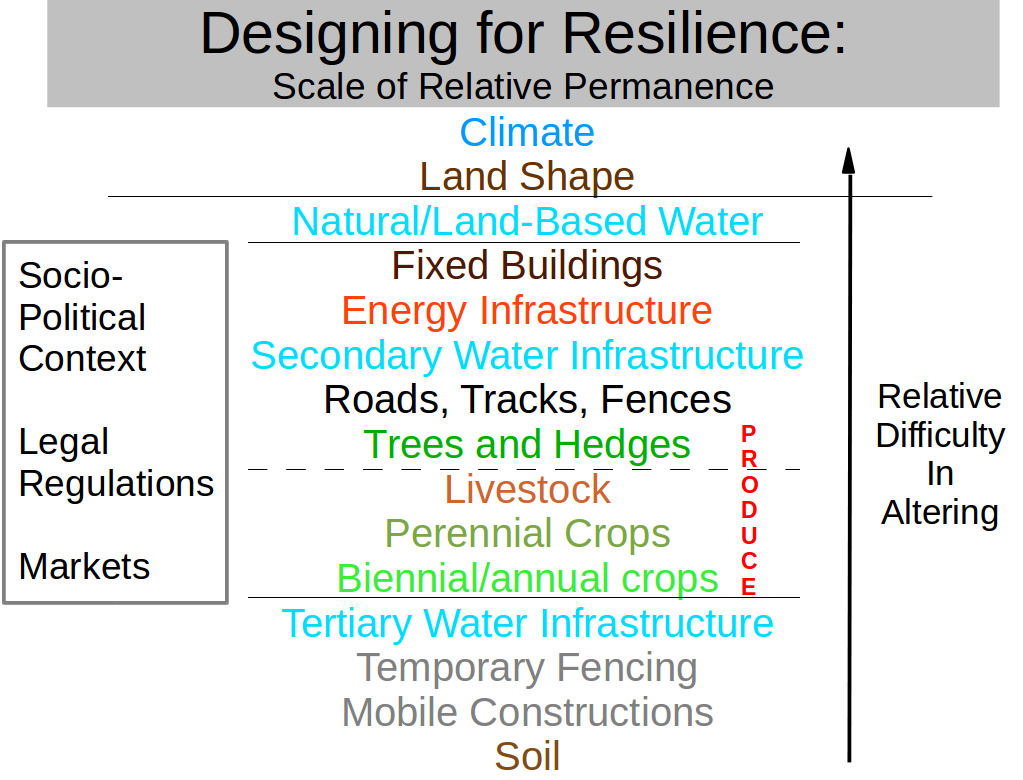This is the first of what will be occasional posts most likely to be of interest to the broader ‘permaculture community’ rather than customers of my produce, who might follow my blog to see what’s going on at the smallholding – although of course there’s no knowing who (if any) will find it interesting. It concerns a framework, or ‘tool’, often used – or at least often mentioned! – in permaculture circles: the Keyline Scale of Permanence (or KSOP). The KSOP was developed by PA Yeomans in Australia from the 1950’s onwards as part of his work towards helping agriculture on that continent become more sustainable, particular with regards to water management, protection of soils, and cropping productivity (especially grass/pasture), in what Alan Savoury would call more ‘brittle‘ environments. Keyline is credited with being a forerunner of permaculture, recognised by both of permaculture’s co-founders (Mollison and Holmgren) as having influenced their work.
In The Challenge of Landscape (1958), where Yeomans sets out his KSOP, he describes it as a “scale of the relative permanence of things agricultural, for the planning, development and management of agricultural lands”, and lists it as:
- Climate
- Land shape
- Water supply
- Farm roads
- Trees
- Permanent buildings
- Subdivision fences
- Soil
He goes on to describe how to use this framework in planning the development and management of land. Space here does not allow exploring this original statement of KSOP – and that is not the purpose of this post; Yeomans’ book, as well as others of his is available free online through the Soil and Health library. A very good article on Planning for Permanence with Yeomans’ Keyline Scale has been published by Owen Hablutzel on the Permaculture Research Institute website.
Amongst adaptations of Yeomans’ KSOP is the Regen10, developed by Darren Doherty, which is structured as follows:
- Climate
- Geography
- Water
- Access
- Forestry
- Buildings
- Fencing
- Soils
- Polymarketing
- Energy
Regen10 is particularly interesting insofar as it incorporates a number of non-land-based contextual issues, items and considerations into the scale. Climate is described as “the various climates of an enterprise, be they human or bioshperic. Effectively these climates create ‘the rules of the game’ in the application of the Regen10”. As well as the ‘human climate’, marketing and energy are included, although their inclusion sets up a tension in what the scale is meant to represent (is this relative permanence of physical land-based farm components or a list/process model for teaching and consultancy?) that for me, is hard to resolve.
Now to how I am adapting Yeomans’ KSOP. When I was developing my first course in Resilient Smallholding last year, one of the tools I looked at when thinking about framing actions was KSOP. I had come across it, very much in passing, in studying for my Permaculture Design Certificate. In organising course materials I was looking in particular at tools that would provide a framework for thinking about the different types of intervention that might be undertaken to make a smallholding more resilient. After quite a lot of reflection, head-scratching and scribbling I came up with a revised scale of permanence that allowed me to make sense of the components of my smallholding (and to be of use when talking to course participants about how they might approach the same issues on theirs). Here is a slide from my Resilient Smallholding course:

A number of things that are going on in the slide need explaining. Firstly, I have loosely grouped together items that might have similar levels of relative permanence by using the horizontal lines – I have done this as an aid to make the scale manageable by suggesting what might be considered together at the same time for planning/design purposes (although this slide is more about sensemaking); and I have appropriately colour-coded items too, for ease of navigation. Similar to the Regen10 model, I have recognised the importance of contextual non-physical/non-land-related issues, although I have offset these from the main scale. I have included and distinguished the main produce types on the land, to a level that is suitable for my smallholding. Finally, I differentiate between three types of water supply – here is the related slide:
When considering the use of the framework as a planning/design tool for use in the smallholding context (as opposed to making sense of relative permanence) I adapted the first ‘scale of permanence’ slide – omitting climate as an area of direct intervention (unlike micro-climate, which can be actively created) and including contextually, not in the scale itself, some key non-land areas where resilience can be built; this highlights the importance of business planning, and in particular the product choices/marketing strategy which will impact at the level of ‘produce’ on the scale. The contexts of community, friends and family, while less directly affecting the scale, are recognised as particularly important in building the resilience of the smallholding.
I hope that the tool could be of help in a broader approach to developing resilience for smallholdings – i.e., by helping to think about, design, prioritise action, and plan the order of works (I recognise that the tool might be more useful in helping select/design a ‘green-field’ site, but believe it might be useful when developing existing smallholdings where infrastructure already exists). It would be great if I could come up with a catchy name/acronym by which I could refer to it; since I feel less qualified to talk about Keyline, other than to refer to it and point towards others more experienced and skilled in its application (Darren Doherty springs to mind), I think I will omit the ‘K’ from my adaptation (although it, and Yeomans, should always be credited as the originators of such models, of course); perhaps I will start with SOPRES, for Scale Of Permanence for REsilient Smallholding, and see how that works.

My slides and work are licensed under a Creative Commons Attribution-ShareAlike 4.0 International License.

